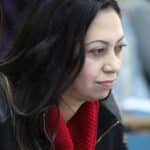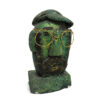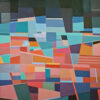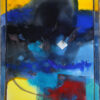Regarding the symbolism of life in sculpture, François-René de Chateaubriand (F. R. C. Briand) said that “sculpture gives marble a soul”. When this carved marble is in an open public space, it is sure to give it a lot of soul, or perhaps the mysteries of it’s daily life. With the installation of any sculpture in a public space, there will be an uproar, many criticisms from the public or experts in the field of art, who want to know about the problems and peculiarities of the naming of sculptural monuments. Its relationship to its public spaces and the context in which it interacts with the pioneers of the place, views and positions on the conditions of sculptural urban and social development.
On this basis, the first International Sculpture Forum of the municipality of Sfax, the session of the late Fathi El-Louz, was convened under the title “Sculpture is a mediator of reconciliation with the ocean” under the initiative of the sculptor and academic Mahrez El-Louz,and under the auspices and supervision of the city of Sfax, and with the support of representatives of regional cultural affairs, the Tunisian Union of Plastic Artists, the Tunisian Artists Association and the Tunisian Culture and Arts Association support. This forum event covers several major sites. It was opened by an international scientific symposium titled “Sculpting Impact in Public Spaces and Interactive Environments” from 2 to 5 August 2022 at a hotel in Sfax, Tunisia.
This title presents us with several Art studies concerning the relationship of the sculptural monument and its interaction with local character, as well as all its material components, social and ideological characteristics, political dimensions and other influences. and their daily activities, the title also suggests to us a field of study that focuses on the intersection of sculpture and other arts, and the interaction with other arts within the framework of this open public space.
The work of this symposium was organized by the Higher Institute of Arts and Crafts of Sfax, which has been supporting the artistic scene in the country thanks to what it proposes of specialized artistic events, open workshops in many arts and periodic exhibitions, and thanks to what it develops in the theoretical acquisitions of its students from the ability to analyze and criticize the reality of arts in the world in general and in Tunisia especially.
Intervention proposals were evaluated by a group of professors. The symposium lasted for four days, and nearly 40 professors in the field of art and art criticism contributed. Guests of Honor from Arab countries, were hosted and honored, like Artist dr. Najat Makki from UAE, who shared her experience in sculpture and Dr. Fouad Al-Khasawneh who talked about the experience of sculptor Kamal Al-Moallem, and his style of sculptures and their symbolism. From a distance, Dr. Ali Al-Jabri from the Sultanate of Oman presented the idea of contemporary Arab sculpture realities through a study of art groups and their role in the emergence of art schools in Europe and even in Arab countries in order to focus attention on the artist groups in the Sultanate of Oman , especially the model of the Sohar Art Gallery.
The international scientific symposium was attended by professors and doctors from the Universities of Tunis, Carthage, Sousse, Sfax, Gabes, Monastir and Kairouan in Tunisia. The intervention raises some questions about the extent to which sculptural effects can integrate form and content into their open public spaces. Some of these relate to the Arab model under study, others to the Tunisian model, while the third part aims to establish a comparative relationship between the Tunisian experience and other Arab or Western experiences. These interventions generally examine the reality of sculpture from its early stages of creation to its latest development in public spaces, and address its relationship to a wide range of political, ideological, sociological and artistic issues. Other interventions address the interdisciplinary issues imposed by contemporary art of such sculptures. The experiences studied in such texts were mainly Western research models or subjective experiences.
The symposium program also included a segment that focused on honoring sculptors with important experiences in the field of sculpture dedicated to public spaces, such as the sculptor Najat Makki (from the United Arab Emirates) and the artists sculptors Abdul Hamid Al-Hajjam, Al-Hashimi Marzouk, Abdul-Aziz Creed and Mahrez Al-Louz (from Tunisia). The Regulatory Authority was keen to include artists from the Arab world and Tunisia, and to present sculptural experiences belonging to different generations of sculptors who left a prominent imprint in the history of art in their countries and established distinctive plastic styles in recognition of their artistic value and definition of their experiences and documentation of their artistic paths and development throughout history.
The works of this elite of sculptors were stylistically and content diverse, as they combined figurative, symbolic, abstract and installation representation. It also differed on the level of subject matter and content, as some of them went towards memorialization and history or towards documentation and representation, while some other works were involved in the context of plastic research for expressive sculptural mechanisms that question materials and exploit the plastic variations provided to them, and others suggested different orbits to express some concepts and visions in a contemporary way which attract several materials that integrate them into interaction and integration relations.
The symposium concluded on its fourth day with a discussion table on “The Art of Sculpture in Tunisia and Marketing Problems”, moderated by Prof. Fateh Ben Amer with group of academics, artists, art critics and journalists who shared in the lecture, also representatives of the City Beautification Committee, the Ministry of Equipment, municipalities and architects were invited to it, given such sculptures target public spaces, which are the common property of the general public, and whose focus in city squares is an area of interest for specialists in urban development in general. The attendees discussed many problems experienced by the sculpture sector at the level of its marketing internally and externally, and the marginalization and exclusion it faces. This discussion was supported by the vivid testimonies of sculptors from different generations who practiced sculpture in Tunisia, such as: Abd al-Hamid al-Hajjam, al-Hashimi Marzouk, Rashid al-Fakhfakh, Abd al-Aziz al-Hassairi, Saleh bin Omar and al-Sadiq bin Turkiya. And enriched by a number of thinkers and academics, such as Ed. Fateh bin Amer, ed. Sami bin Amer, ed. Khalil Quwaya, Dr. Sami Al-Qalibi, and a significant number of specialists in the field of sculpture and art in general.
This round table produced a number of recommendations that focused on clarifying the definition of sculpture in the mind of the common citizen and correcting the misnomers called sculpture art products (such as statues, monuments, idols…), in addition to the need to reconsider the relationship of sculpture to the ocean, meaning Its relationship to space, the citizen, and the activities of the place. The interventionists stressed the importance of encouraging the sculptor in Tunisia and ensuring his material, moral and moral rights, with the need to preserve his dignity and ensure his artistic, intellectual and material independence.
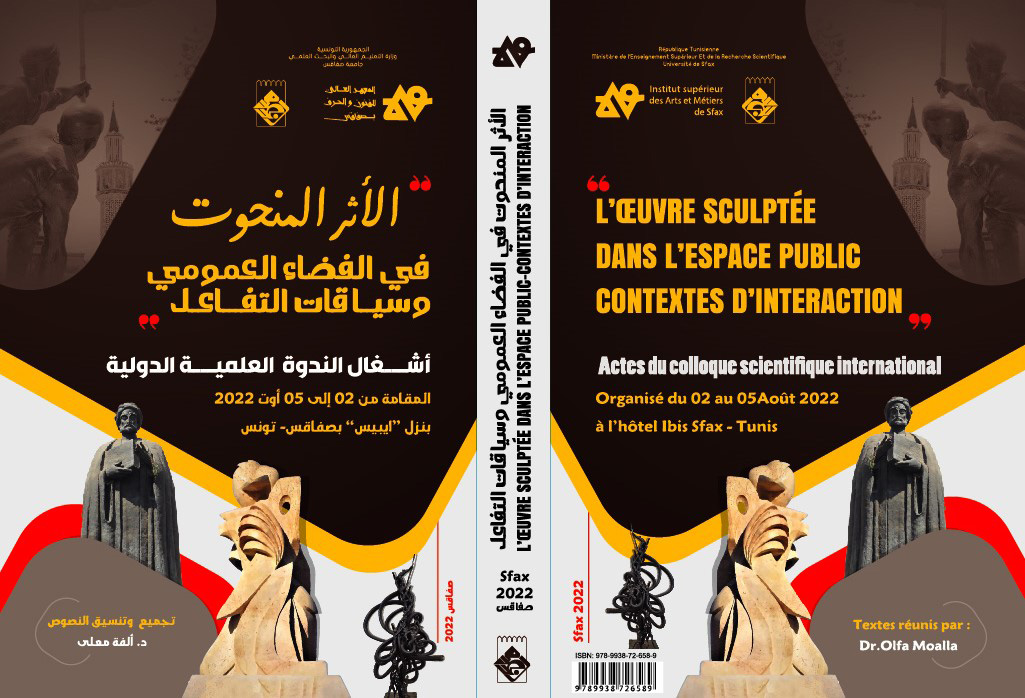
Moreover, they were exposed to the necessity of reconsidering the debates on some of the requests allocated for furnishing public squares, the good selection of those in charge of them, and the obligation to abide by the specifications when completing such sculptures. With regard to the issue of marketing sculptural works, the artists called for the priority of creating exhibition halls equipped to attract and display sculptural works and the appropriate lighting and distance required to surround and read the sculptural work from its various facades, as well as specialists in coordinating and placing sculptural works in the interior space of the exhibition. As for the issue of external marketing, they indicated its almost non-existence and impossibility for organizational and logistical reasons mainly, so they stipulated the need to find appropriate solutions to market their sculptural achievements outside the country in order to publicize them, and they stressed the importance of hosting sculptural experiments from other countries in support of the cross-fertilization of experiences and benefiting from each other’s creations.
In order that the content of these important interventions and discussions would not be blown away by the wind as dust is scattered in space, and in order for the international scientific symposium to achieve its purpose and goal, the organizing committee worked on documenting its outputs in the book “The Sculpted Effect in Public Space and Interaction Contexts,” which was issued in conjunction with the holding of the conference. Symposium.
The cover of the book bore sculptural models of different materials (iron, bronze, marble…) and various styles (including representational, symbolic and abstract) in reference to the diversity of research samples adopted in these texts. The author included approximately 33 texts in Arabic and French by academics, professors, and critics from Tunisia and the Arab world and was divided into three main axes: The first axis dealt with the topic of “the sculpture in the open public space and the problems of its integration into it in form and content”, its texts concerned the experiences of sculptors from Tunisia or from the homeland. The Arab and included different eras from the era of pioneers to the last sculptures erected in public space. Then, in a second axis under the title “Contemporary Obligations and the Interference of Disciplines in Public Space Sculptures,” the texts discussed and analyzed mainly Western works or subjective experiences in the field. The third axis was specifically devoted to honoring sculptural experiences belonging to different periods and different countries.
Methods for researching the entire texts contained in the book are diverse, as they ranged between the historical, descriptive, analytical and critical method, and based on the method of comparison by disagreement or agreement. The texts raised many burning problems and issues affecting this type of arts, and made many recommendations and suggested some solutions and alternatives. Here was the goal of the international scientific symposium, the refereed, as it dealt with immediate issues that concern public opinion and the category of artists, critics and theorists as it talks about the space of their social presence and the theater of their daily movements and activities.
In parallel with the work of the symposium, a sculpture exhibition was organized in which about 13 sculptors from Tunisia and abroad participated. It opened on August 02 2022 and continued until August 15 2022 in a hostel in Sfax. The sculptural works displayed were done with different materials, as marble of all colors and types, as well as resin, wood, iron and metal, and the owners relied on different techniques such as carving by deletion, molding or assembly. In general, the sculptors focused their attention on the specificity of technology and the method of forming materials and adapting them according to their artistic perceptions. The sculptures often came in an abstract style far from all representational simulation, in which the sculptor questions the specificity of materials and adapts their intransigence and stubbornness and employs what is in them of weaving and natural colors through which he draws the features of his formations Sometimes soft, smooth, curved lines, and sometimes sharp, straight, geometric lines. Through its zigzags, slopes, protrusions, hollows, and tactile weavings, each sculptor presented the focus of his conceptual interest, his plastic research, and his own style of expression and formation.
This exhibition specialized in the art of sculpture was an opportunity to present to the public another type of sculptural models that can be found in the interior spaces, in order to realize the difference between them and the sculptures observed to furnish open public spaces. Therefore, most of the exhibited sculptural works were received in relatively small sizes, except for a few.
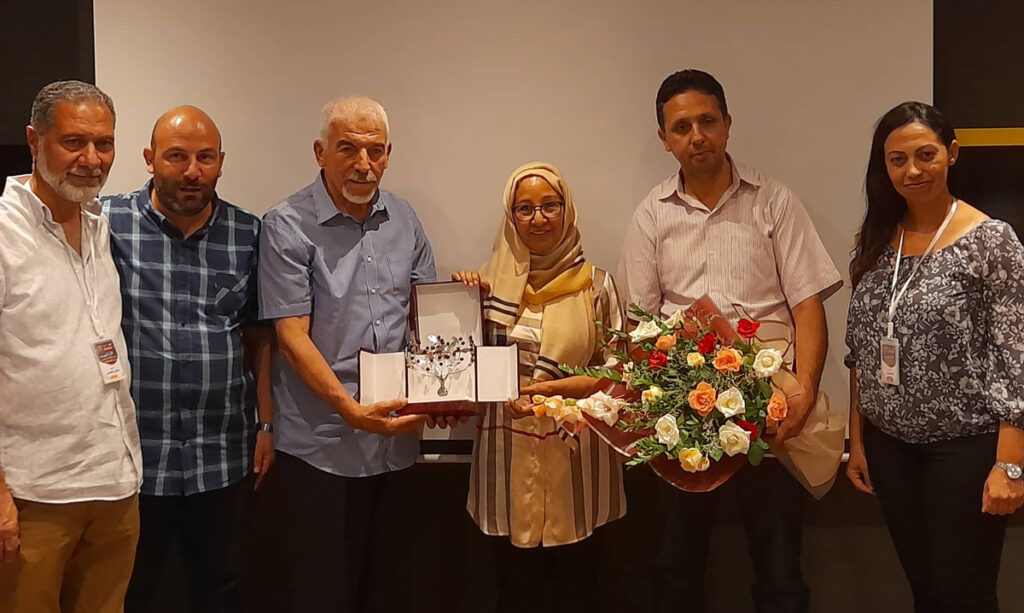
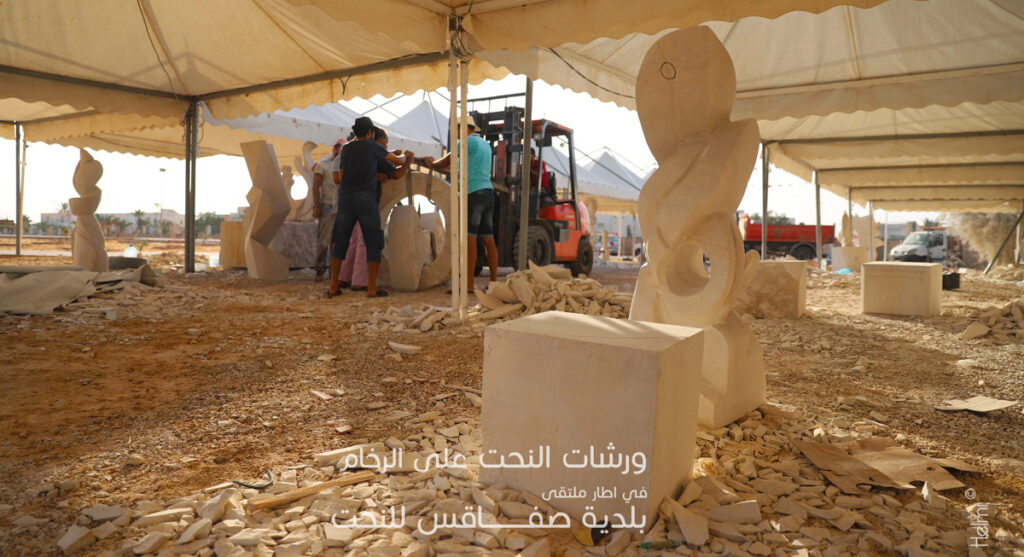
The completed works were distinguished by their different content, conceptual and technical propositions, as the sculptor Muhammad Sahnoun went to employ the Arabic letters in a curious sculptural composition that deviated from the usual circulating due to the inclination of the center of its visual balance and its marriage between the curved line that obeys the letter and the geometry of its background and base,

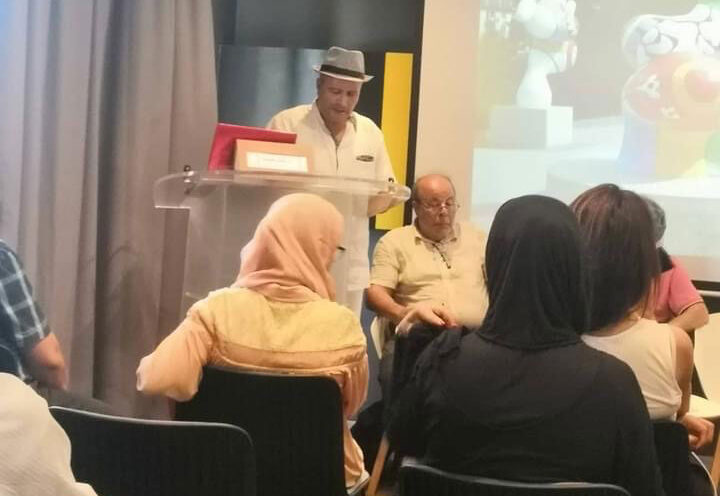
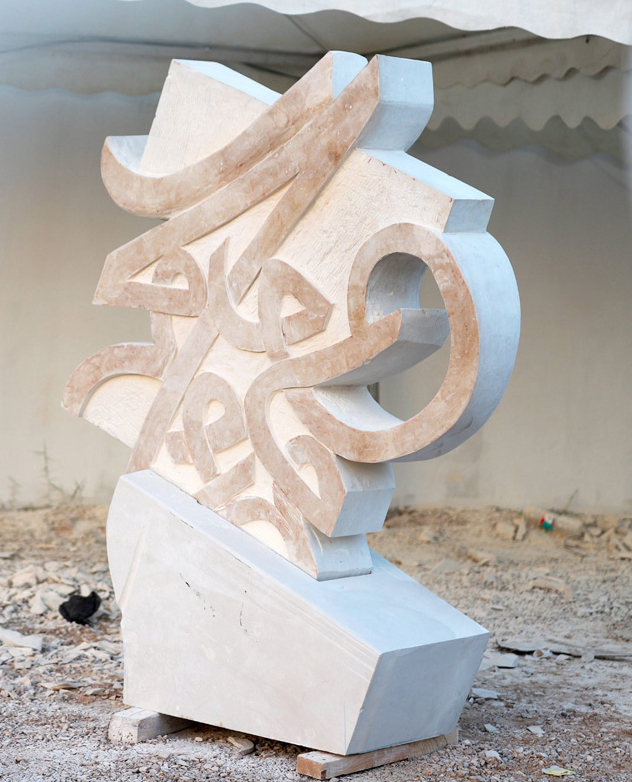
Then, at a later stage, the work of the living marble sculpting workshops began on August 06, 2022 and continued until August 17, 2022, and stipulated the completion of marble sculptures that exceed two meters in height at least, for the furnishing of public spaces in particular. About 15 sculptors from Tunisia and abroad and students in the field of sculpture participated in these workshops.

and other sculptural works went to employ straight lines And the flat planes and the acute and obtuse angles to present mainly abstract formations, such as the sculptures of Bayram al-Awni and Seif al-Din bin Hammad, which manipulated light and shadow due to the variation in the degrees of inclination of the smooth surfaces and the different directions of their slope, or on the example of the sculpture of Abdel Karim Karim, who titled “Contemplation” and whose structure they built. On formations of symbolic dimensions that touch on spiritual concepts and marry rough with polished.
In the type of formations based on curves, circular lines, and spirals, an important number of other sculptural works were included, such as the sculpture of Hatem Al-Shuaili, which is based on an abstract geometric composition mainly inspired by the circular shape, or Taher Hudhoud’s sculpture based on the shape of an ascending spiral, or also as the sculpture of Khaled Al-Feqi, the shape of the spinning fish. And the movement of the dancing waves in a sculptural and symbolic combination that distances itself from representation, and in the same context, Lubna Qabado goes with the same source of inspiration (the fish and the sea) to broader orbits of lyrical abstraction, where the lines wrap themselves in a spiral direction that sometimes contracts and sometimes dissolves. Through this same attractive curved line, the sculptor Abdelaziz Creed, on the other hand, embodies the contrast of the cold and fresh sea water through his “flame” that ignited the marble material, fragmenting and rising in a vertical direction. Reem Maali and Sami Al-Qalibi, in turn, had adapted the marble material and adopted the softness of the line and its curves as an expression of the delicate movement and posture of the female body, while Abdel Aziz Al-Hassairi went to employ these same expressive mechanisms in a symbolic embodiment this time of two embracing bodies that united, united, and united, so as to form a strong fusion. He moved towards distorting the hardness of the marble material and turning it into a runny substance that upsets the Earth’s gravitational scales by making its drops fall, but in an upward direction. The work of the sculptor Salih bin Omar adds to the marble material of fine texture, tubes of other hybrid materials that penetrate its calmness to draw shadows on the whiteness of the marble and re-sculpt the sculpture in silhouette.
With its three paragraphs, the forum provided an opportunity to introduce the art of sculpture and tried to shed light on the problems it suffers from misunderstanding, presentation and marketing. He believed in the importance of cultural cross-fertilization and the exchange of experiences and expertise through his openness to Arab experiences in the field. Space and its pioneers), raised many issues and suggested some solutions to them, leaving the field open for much controversy and discussion.
The work of the forum as a whole was concluded on August 18, 2022, but it opened doors for creativity, discussion and dialogue which won’t be closed.

Assistant Professor at the Higher Institute of Arts and Crafts of Sfax, holder of a doctorate in sciences and techniques of art from the Higher Institute of Fine Arts in Tunis.


